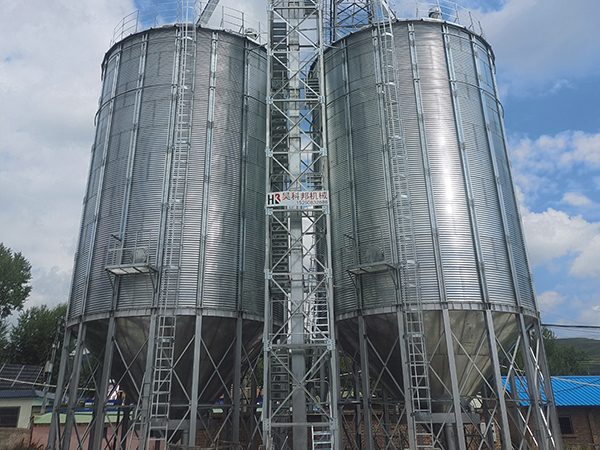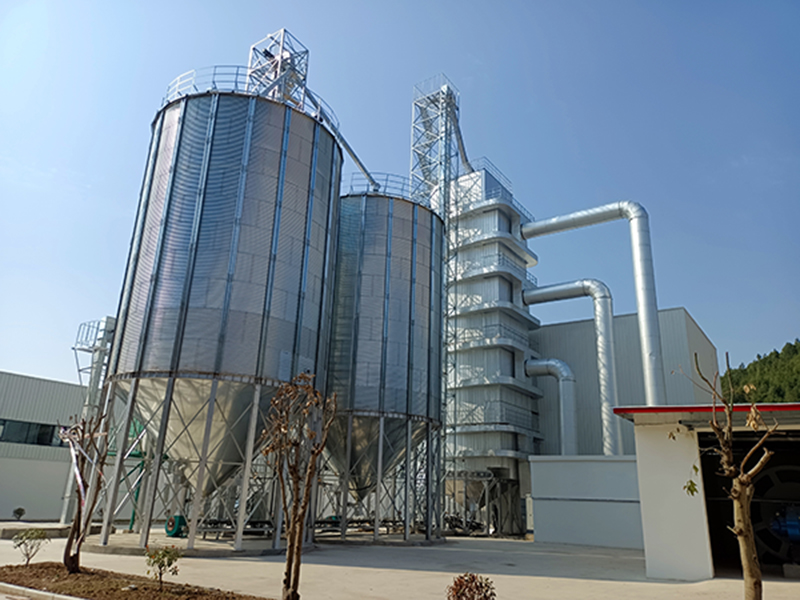HKB Grain Silo is widely used for grains storage such as wheat, corn, soybean, paddy, rice, soybean meal, barley, malt, sunflower seeds, rapeseeds, peanuts, flour, and other powder materials, oat, special grain, and seeds, etc.
HKB grain silo is made of high-quality 275g/m2, 300g/m2, 350g/m2 hot-dip galvanized steel, widely used for grain storage such as wheat, corn, soybean, paddy, rice, soybean meal, barley, malt, sunflower seeds, rapeseed, peanuts, flour, and other powder materials, oat, special Silo, and seeds, etc.It has corrosion resistance, high shock resistance, and long service life.
Henan Haokebang Machinery Equipment Co., Ltd. is located in Henan, China. It specializes in producing grain processing equipment such as grain dryers, silos, tubular dryers, mesh belt dryers, and grain cleaning screens. It can provide users with a single equipment solution and equipment for a complete set of grain washing, drying, storage, and selection systems. As well as professional customized service technical support, reliable spare parts supply, and high-quality after-sales service. Look forward to working with you!

When designing rice paddy silos, it is essential to ensure they can resist external forces such as wind loads, snow loads, and seismic activities. Additionally, the silo structure must be capable of withstanding the lateral pressures generated by the stored grain, which is particularly important for different types of grain, various storage methods, and different heights of grain storage to prevent the silo walls from cracking.
Beyond lateral pressures, the design of rice paddy silos must also take into account the vertical pressures exerted by the grain on the floor. This consideration is to prevent the floor from subsiding, ensuring the stability and safety of the silo.
When planning the doors, windows, and openings of a silo, it is crucial to consider the logistics of grain entry and exit as well as the ease of daily management. To meet the silo’s airtightness and storage process requirements, the number and size of windows should be minimized.
We should carefully design the window opening mechanisms to ensure adequate ventilation and to facilitate grain replenishment operations, thereby enhancing overall operational efficiency.
The placement of silo doors should prioritize the swift and convenient movement of grain, while also taking into account grain storage safety, internal road planning, and the convenience of loading and unloading on dedicated railway lines.
For small-span silo, we typically design doors on one side to avoid direct sunlight; on the other hand, for large-span silos, we may design doors on both sides, adopting an asymmetrical layout to optimize space utilization and workflow.
To facilitate easy access for custodians, the design of small doors or manholes for grain condition inspection in the silo must be carefully planned. Each bungalow-style silo (storage room) only requires one small door for grain inspection.
Grain inspection doors are typically located on the north side or gable end of the silo, with an external inclined ladder provided for custodians to conveniently carry items up and down.
For deep grain storage silo, including shallow round bins or cylindrical silos, we must install a manhole at the top, near the eaves, and provide an internal ladder on the silo wall to ensure custodians can safely ascend and descend.
A manhole should also be provided at the bottom of the silo for cleaning during empty periods and for equipment maintenance.
We should design the structure of manholes to be easily operable by custodians and to provide effective sealing when the silo is in use, ensuring the safe storage of grain and protection from external contaminants.
Grain retaining plates (doors) are engineered to address the lateral pressure exerted by loose grain against the silo walls, a feature particularly important in flat-bottomed silos where the main door does not directly bear the grain’s lateral pressure, and the retaining plate assumes this responsibility.
A discharge port is strategically incorporated at the bottom of the grain retaining plate to facilitate the grain outflow efficiently before the plate is opened.
A variety of designs are available for grain retaining plates, accommodating different silo configurations. Although installation may present some challenges, these designs are ultimately aimed at ensuring smooth grain discharge, thereby enhancing overall work efficiency.
When opting for grain retaining plates, gaps should be pre-emptively left in the U-shaped fixed slots of the wall to facilitate the easy installation and removal of the plate when necessary.
When employing V-shaped grain retaining plates, it is imperative to install a protective canopy above the inner wall of the doorway. This measure is designed to prevent the formation of a triangular deep recess at the location of the plate.
Given the typically dim lighting inside the silo, this design feature is crucial for preventing safety incidents that could occur during grain inspections by custodians.
The integration of a canopy in the design of V-shaped grain retaining plates is a key component in ensuring the safe operation of the silo, safeguarding both the stored grain and the personnel conducting inspections.

1. Large reserves, single warehouse can store 10,000-100,000 tons
2. Low investment, investment per ton storage is less than 200 yuan, less than 50% of that of concrete warehouses, easy to operate, and the outbound rate reaches 95%
3. The construction period is short and can be completed and put into use in 3-4 months.
4. The overall performance is good, environmentally friendly, energy-saving, land-saving, and has a long life. It can be used for 50 years.
5. The fourth-generation rice paddy silo incorporates more advanced technology, resulting in a higher emptying rate and an improved homogenization effect. Additionally, the equipment within these silos is designed for easy maintenance, repair, and replacement.
After years of practice and a large amount of experimental research and improvement, the fourth-generation warehouse adopts the method of multi-point cutting and matching discharging, which solves the problems of the previous generations of warehouses, such as large-diameter landings, large stocks of materials on the sides of the warehouse, and poor delivery rates. Technical problems include low temperature, poor homogenization effect, and inability to repair and replace equipment in the warehouse.
Scientifically speaking, the Grain Silo capacity should be measured with volume (m3). Even in the same grain Silo, the storage tons will be different for different grains with different densities. The following table is calculated based on a Silo density of 0.75kg/m3, and surely HKB customizes Silo systems unique for you.
| Most Popular Hopper Bottom Steel Silo Technical Specifications | ||||||||
| Capacity | 50Ton | 100Ton | 150Ton | 200Ton | 300Ton | 500Ton | 1000Ton | 1500Ton |
| Model | TCZK
03605 |
TCZK
04507 |
TCZK
05507 |
TCZK
06406 |
TCZK
07307 |
TCZK
07313 |
TCZK
11010 |
TCZK
12811 |
| Diameter(m) | 3.667 | 4.584 | 5.500 | 6.417 | 7.334 | 7.334 | 11.000 | 12.834 |
| Total Height(m) | 9.56 | 12.53 | 13.25 | 12.85 | 14.70 | 21.42 | 20.95 | 23.51 |
| Volume(m³)
Density:0.75ton/m³ |
69 | 150 | 222 | 273 | 415 | 699 | 1346 | 2039 |
| Most Popular Flat Bottom Steel Silo Technical Specifications | ||||||||
| Capacity | 1000Ton | 1500Ton | 2000Ton | 2500Ton | 3000Ton | 5000Ton | 8000Ton | 10000Ton |
| Model | TCK
10014 |
TCK
11915 |
TCK
13715 |
TCK
15514 |
TCK
15518 |
TCK
18321 |
TCK
24718 |
TCK
25621 |
| Diameter(m) | 10.084 | 11.918 | 13.750 | 15.584 | 15.584 | 18.334 | 24.751 | 25.668 |
| Total Height(m) | 18.69 | 20.34 | 20.87 | 20.30 | 24.78 | 28.60 | 26.99 | 30.60 |
| Volume(m³)
Density: 0.75ton/m³ |
1335 | 2009 | 2701 | 2467 | 4145 | 6693 | 10879 | 13484 |